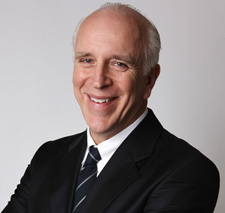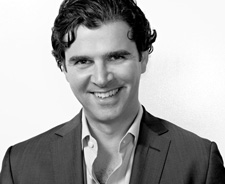Fifteen years ago, when I was an editor at New York magazine, I had a little side project: I got to launch nymag.com as the site’s founding editorial director. The site’s first advertiser was Armani A|X.
Because I had scant dedicated staff at the beginning, it fell to me to solicit the advertising materials—specifically banner ads, which would go into rotation on nymag.com—from Armani’s marketing department. At the time, banner-ad specs were still a new-ish thing. Having done display ads in odd sizes for the big dial-up portals (AOL, CompuServe, etc.), marketers were still figuring out how to advertise on the Wild West of the Web itself.
The Interactive Advertising Bureau (IAB), the organization that sets standards for, among other things, banner-ad sizes, was just a year old. (Google didn’t even exist yet; it launched in 1998.) When the Armani A|X banner ads arrived in my inbox, they didn’t fit our standard banner-ad slot atop the nymag.com site template. I remember the business-side person who sold the space to Armani asking me if we couldn’t just “rework” the website to accommodate the odd-shaped Armani banner. Because they were an important advertiser and all. Um, no. (The Armani team ended up graciously resizing their banners.)
A decade and a half later, well, the more things change, the more they stay the same. Media companies that support their journalism habit with advertising have generally settled on a bunch of standards (thanks largely to the IAB), but at the same time they’re bending even farther over backwards to cater to marketers’ wishes. Advertisers are demanding, and getting, all sorts of special considerations, including envelope-pushing site takeovers (sponsor branding that temporarily blankets Web pages) and custom-content sections.
At the same time, of course, the ground is shifting for everyone, as the rise of social media, mobile platforms, apps, etc., radically alters the meaning and relevance of the cpm (cost per thousand) and the place of the basic banner ad in the Web ecosystem.
To examine how the media ad-sales business is changing with the times, I spoke with the advertising chiefs at three very different companies. First, I went back to my old stomping ground: New York, a legacy print company whose weekly magazine launched 44 years ago (I no longer have any business or editorial relationship with it). Then I went to Salon, which you might call a legacy Web company, given that it is one of the original Internet-only magazines (it launched in 1995). And finally, I checked in with Gawker Media, the company that transformed and legitimized the blog-publishing landscape; its flagship, Gawker, launched in 2002. All three are, in many ways, competitors; as such, they’re grappling with similar challenges.
The quotes below, taken from much longer conversations, have been edited for space and clarity.

Larry Burstein is the longtime publisher of New York magazine. For what was long a print-only property, New York derives an unusually high amount of revenue—40 percent—from digital.
On creating custom programs for advertisers: We do custom programs, but we don’t do them because the banner is dead. We do them because the Web is this center for innovation, and every advertiser is trying to outdo the advertiser before, and every advertiser is demanding something new that they’ve never seen before. They don’t come and say, “Hey, the banner is dead; we need something else.” They say, “Hey, we want to buy space with you, but we also want to use your site in the best possible way.” This is kind of the challenge that’s been put out in the Web world: “We want to do a buy that is 10 million impressions, but we want to do it in a way that’s never been done before.”
What a media-company promotions department now does: The promotions department—at our company, at least—has morphed into this kind of think tank and solutions group for the Web. In the past they were, like, making T-shirts and beach umbrellas and stuff like that; now they’re sitting around trying to figure these questions out.
When agencies and advertisers push their luck: We won’t have editors blogging about advertisers’ products. We’ve come up against competitive buys where sites will do that for advertisers, and we won’t do that. We’ve come up against competitive buys where sites will completely redo their homepage, which really disturbs the user experience in order to please an advertiser. Our feeling is that the advertisers we’re doing business with really don’t want the user experience disturbed because of them.
On the future of mobile advertising: We’re working with this new technology which we’re calling Responsive Media, where we’re optimizing every single thing that we do for all possible screens—it’s built into the development of these different products that we’re doing. For instance, in The Cut [nymag.com’s newly expanded fashion vertical], anything that you see on your browser will be optimized for the tablet and the phone. Some advertisers are saying, “Hey, X number of impressions are going on mobile, and you’re not optimized for mobile, so the ad doesn’t look good, and we’re not going to get response.” So we’re addressing that.
On monetizing social: It’s not a direct monetization. We’ve been very aggressive on mobile lately on both Facebook and Twitter. If you get the right story out there in the right way on Facebook or Twitter, it pays back in huge numbers of visits to the site, to the story that was linked—so we then get to monetize that traffic. That’s how we monetize social.
The next-generation circulation department: What we used to call the circulation department is now the audience development department. We have two people completely dedicated to enhancing our social position, and since they’ve been here, the traffic has jumped significantly. You can see it from what they’re promoting and how the traffic has played out.

Matthew Sussberg joined Salon as its VP of advertising in June; he previously worked at Wenner Media and The Huffington Post.
On the “death of the banner”: Everyone wants to know what’s the next step in online advertising. But to say that the banner is dead is silly. It would be like saying that a cover-4 [the back cover of a magazine] or a 30-second spot on Modern Family is no longer important. You still need to drive awareness; you still need to have a ton of eyeballs on one spot. At the end of the day, a client wants to know that X number of million people are seeing their ad.
This is not your grandfather’s banner: The banner ad has gone from a banner to this huge splash ad, push-downs, and overlays—so when you say the banner is dead, I can see how for some people that does ring true. But the banner itself has evolved; there’s just so much more that you can do with it. It went from just a GIF or a JPEG, a static image, to—now we’ve got a unit on the site that you could run a full 30-second video in. I guess you still consider it a banner unit, but it does so much more than what a banner unit did 12 months ago, let alone 36 months ago. It’s constantly evolving.
The (still) big business of display: I would say banner buys represent 70 percent of our revenue. I don’t know that that’s going to be the case moving forward; we’re going to evolve with our clients and what other publishers do. You always have to be on the forefront of whatever the next big thing is.
On creating custom content for advertisers: The other 30 percent [of revenue] includes branded entertainment pages where we’ll figure out a way to create a custom content area, if you will, that speaks to the client’s objectives. For Salon, it’s a sophisticated, educated, affluent user, so we’re not going to be talking about disposable razors—but could we come up with a custom content area that speaks to the intersection of style and technology for a luxury car maker? Absolutely.
On editorial integrity: There is obviously a church-and-state divide. A lot of times we present what we think is a great idea but the client says, “No, we want X, Y, and Z,” and we’ll just have to go back to them and say unfortunately we can’t do that. Certain publishers definitely cross over that line. I’ll tell a client, “We want to create something for you that is going to be successful for us, and that means our users are going to want to read it and want to share it with their peer group. If you guys are too heavy-handed, it’s not going to work. You can tell us you want a slideshow about your automobile. Sure, we could create that for you, or someone else could create that for you. But no one is going to read that.” That’s just an ad unit.
An example of a Salon custom campaign: We recently completed a campaign for Bulgari. They wanted to reach dads and grads—it was a graduation/Father’s Day campaign. They were looking to tap into masculine charisma, and so we created an original series about the idea of fathers passing on cultural touchstones: things that fathers wanted to pass onto their sons and daughters. We had contributors like Nick Hornby, Rick Moody, Captain “Sully” Sullenberger of the Miracle on the Hudson. It was 100-percent sponsored in a series that we created exclusively for Bulgari. It didn’t in any way rob the Salon user of the content that they’re used to. These were very high-quality pieces.
On the future of mobile: I think for certain advertisers, mobile is the right platform, because they want the person on the go—they’re constantly on a plane flying from one business trip to another, or they’re a busy mom or dad. When you’re trying to reach that person, mobile is the right space, but it’s a small screen, and you can’t do those big splashy ads. But with the gps on your phone, being able to super-geo-target you down to where you’re standing—let me send [you] an ad for the nearest Starbucks.
Bigger mobile ads are coming: If, in 10 years, 75 percent of content is consumed on mobile, the ads are just going to get bigger. That’s just the way it is, so long as the content is free; that’s the trade-off. The ads are just going to get bigger, and you’re going to have a full-page takeover on your iPad 11; you’re going to sit through 15 seconds of advertising to access the content that’s free. Salon being around for so long, for 17 years, we’ve ridden all these different waves of ways to monetize the Web. It costs money to produce content, so how do you pay for it? We’re not a dot-org; we’re a dot-com, so there has to be a means to keep the lights on.

Andrew Gorenstein is chief advertising officer at Gawker Media. He was previously senior executive director of digital sales at Condé Nast.
On homepage roadblocks: If you see a brand image above the splash [main] image on any of the Gawker Media homepages, that is part of a homepage-roadblock experience. It’s a nice way to showcase a sponsor in a way that’s actually very native to our experience and not something that you get elsewhere on the Web. Couple that with the display ads that we provide on the page and we’re trying to cut through clutter. We have a lot of success with that.
On custom content deals with sponsors: We were seeing such demand for sponsored content, and because we really do see it as one of the key points of differentiation for us, we built an internal creative services team, which is essentially like a studio within Gawker. So an advertiser would say, “We want to reach the Gizmodo [gadget enthusiast site] audience and we have this particular message.” They work with our folks to apply the appropriate tone and feel for Gizmodo, to ensure that it has the best potential to really resonate with the audience, as opposed to just some boilerplate corporate copy. The fact that the content is slugged “sponsored” is really secondary, because if it’s good and there’s a benefit to the reader, then that’s still a positive experience.
An example of sponsored content: We had a Comic-Con sponsorship with Sprint, and the package that our team put together garnered over a million pageviews.
On mobile: With mobile we’re talking about handheld and tablet. With handheld, to be honest, the consumption is because it’s convenient. I’m walking down the street, I’m on my device and I can gobble up five articles and that’s great. But from the advertising side of it, half the time you can’t even read whatever the particular call to action in the ad unit is. There just has to be a better experience that can be brought to the user so people can really monetize it. We spend a lot of time thinking about it now. The tablet mimics the desktop experience, which is much cleaner. I think there are a ton of cool things that can happen with swipe and things of that nature, but on handheld it’s really tough.
On creating richer ad experiences on the Web: When you see a beautiful ad spread in a magazine, it catches your eye. There’s a richness to that experience. That’s what’s been so difficult for people to replicate online. With larger ad units and more of the interactivity that provides, there’s more of that engagement. Without that richness, you’ll have a wonky ad sitting there and you’re, like, “Why is this thing blinking at me? It’s distracting me.” It doesn’t have to be a distraction.
Simon Dumenco is the media columnist at Advertising Age and a contributing editor at Details. He’s a veteran of both print (e.g., he was editor of the National Magazine Award-winning media column at New York magazine and consulting executive editor on the launch of O: The Oprah Magazine) and digital (he was founding editorial director of nymag.com and founding editor of Very Short List, etc.).
